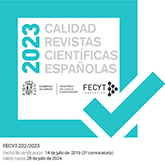Contextos cerámicos de los siglos V-VII en Cartagena
DOI:
https://doi.org/10.3989/aespa.1996.v69.238Abstract
The excavations realized in the Roman theatre of Cartagena have documented a wide stratigraphie sequence with covers levels from IInd century B.C. to today. The material contexts of Vth to VIIth B.C. are specially interesting because they were associated with considerable removals of the town planning. The construction of a comercial site in the second half of the Vth century, markets and stores, built on a big exedra with portico and 15 divisions in line, represents the total use of the theatre, the structures of which became fossilized, in part, in a new shape. A village of Byzantin age was built over both constructions, characterized with quadrangular rooms which alternates with opened public spaces and irregular streets adjusted to the artificial and inclined topography dependent on the precedent constructions.
Downloads
Download data is not yet available.
Downloads
Published
1996-12-30
How to Cite
Ramallo Asensio, S. F., Ruiz Valderas, E., & Berrocal Caparrós, M. del C. (1996). Contextos cerámicos de los siglos V-VII en Cartagena. Archivo Español De Arqueología, 69(173-174), 135–190. https://doi.org/10.3989/aespa.1996.v69.238
Issue
Section
Articles
License
Copyright (c) 1996 Consejo Superior de Investigaciones Científicas (CSIC)

This work is licensed under a Creative Commons Attribution 4.0 International License.
© CSIC. Manuscripts published in both the printed and online versions of this Journal are the property of Consejo Superior de Investigaciones Científicas, and quoting this source is a requirement for any partial or full reproduction.All contents of this electronic edition, except where otherwise noted, are distributed under a “Creative Commons Attribution 4.0 International” (CC BY 4.0) License. You may read here the basic information and the legal text of the license. The indication of the CC BY 4.0 License must be expressly stated in this way when necessary.
Self-archiving in repositories, personal webpages or similar, of any version other than the published by the Editor, is not allowed.














